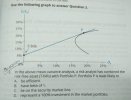You are using an out of date browser. It may not display this or other websites correctly.
You should upgrade or use an alternative browser.
You should upgrade or use an alternative browser.
Mean variance analysis
- Thread starter Akriti1
- Start date
Hi @Akriti1 Yikes, I agree with you, this question is flawed. At a minimum, it seems the construction is insufficient. The answer is not (C). We should expect the Portfolio to lie on the SML because we can expect any portfolio to lie on the SML per my personal favorite distinction, see e.g., https://forum.bionicturtle.com/threads/capm-sml-cml.5347/post-23187
If P is the Market portfolio, then (B), (C) and (D) are also all true (i.e., if P = M, then statements B, C and D are true and therefore cannot be correct answer to the "least likely" question!). Apparently, it is not the Market Portfolio in which case (B) or (D) do not need to be TRUE. So, to me, (B) and (D) are equally possible as false (i.e., not necessarily true). While (A) and (D) must be true; i.e., are likely. Actually, there is no way to know if (P) is the Market portfolio, or merely the efficient portfolio with the highest Sharpe ratio conditional on the riskfree rate assumption.
I think it's a flawed question.
We can discard choice (A): portfolio P is efficient because nothing is obviously better; i.e., nothing lies in its upper-left quadrant that could enjoy better return for the same risk, or lower risk for the same returnMy favorite distinction between SML and CML is: CML is only efficient portfolios, but the SML includes any portfolio, including non-efficient portfolio
If P is the Market portfolio, then (B), (C) and (D) are also all true (i.e., if P = M, then statements B, C and D are true and therefore cannot be correct answer to the "least likely" question!). Apparently, it is not the Market Portfolio in which case (B) or (D) do not need to be TRUE. So, to me, (B) and (D) are equally possible as false (i.e., not necessarily true). While (A) and (D) must be true; i.e., are likely. Actually, there is no way to know if (P) is the Market portfolio, or merely the efficient portfolio with the highest Sharpe ratio conditional on the riskfree rate assumption.
I think it's a flawed question.
@David Harper CFA FRM thanks... just completed the practice set on capm and scored 26.5 on 32 questions... read about this and found that 100% risky portfolio can exist in the presence of risk free asset. Infact, market portfolio is the most efficient portfolio and a, b and d are the characteristics of the same. Since, risk factor in the diagram is standard deviation (total risk) , it is least likely to lie on SML.
Hope, I am correct to understand it so!
Hope, I am correct to understand it so!
Hi @Akriti1 Thanks but um, no, it's a flawed question and perhaps even counterproductive. Why? Because it penalizes a more knowledgeable candidate!
If (b) is false, then (c) must also be false: If we can expect the Portfolio to have a beta of 1.0, then we can also expect it to lie on the SML! More profoundly, as mentioned, we can expect all portfolios to lie on the SML. The best answer to this question is actually (B). But the fundamental problem is that the question is flawed because the writers lack an understanding of mean-variance and CAPM theory.
First, there are no assumptions provided to require that portfolio P is the Market portfolio. The "mean-variance" assumption is only one of the CAPM assumptions. CAPM implies mean-variance but the converse is not true. The curved line that plots return versus volatility is merely a Portfolio Possibilities Curve (PPC). The PPC can be constructed with only two assets, and it often is thusly constructed (!), but that doesn't make P the Market portfolio obviously. Portfolio P is simply the most efficient portfolio on the PPC (i.e., highest Sharpe ratio) conditional on the given riskfree rate (the most efficient portfolio is actually variant to the riskfree rate which you can visualize by shifting up/down the riskfree rate and realizing that the point of tangency moves!). Probably/possibly the question writer intends for the it to be the Market Portfolio but the assumption(s) to justify that should be provided.
Second, because there is no assumption given to justify evaluating Portfolio P as the Market Portfolio, the best choice is (B): among the given set of risky assets, it is highly plausible that Portfolio P has a beta that is not exactly equal to 1.0.
Third, as mentioned, we should understand why (C) is technically wrong: the CML is efficient, but the SML manifests CAPM and plots the expected return of a portfolio/asset (as a function of its systematic risk, beta w.r.t. the Market Portfolio) for any security. We can expected Portfolio P to like on the SML, like we expect any of the less efficient portfolios on the PPC to lie on the SML! If P does not lie on the SML, then an arbitrage is possible (and this in fact a classic FRM type question).
Fourth, here are two possible answers which could replace the problematic choice (C), to the question "Portfolio P is least likely to"
If (b) is false, then (c) must also be false: If we can expect the Portfolio to have a beta of 1.0, then we can also expect it to lie on the SML! More profoundly, as mentioned, we can expect all portfolios to lie on the SML. The best answer to this question is actually (B). But the fundamental problem is that the question is flawed because the writers lack an understanding of mean-variance and CAPM theory.
First, there are no assumptions provided to require that portfolio P is the Market portfolio. The "mean-variance" assumption is only one of the CAPM assumptions. CAPM implies mean-variance but the converse is not true. The curved line that plots return versus volatility is merely a Portfolio Possibilities Curve (PPC). The PPC can be constructed with only two assets, and it often is thusly constructed (!), but that doesn't make P the Market portfolio obviously. Portfolio P is simply the most efficient portfolio on the PPC (i.e., highest Sharpe ratio) conditional on the given riskfree rate (the most efficient portfolio is actually variant to the riskfree rate which you can visualize by shifting up/down the riskfree rate and realizing that the point of tangency moves!). Probably/possibly the question writer intends for the it to be the Market Portfolio but the assumption(s) to justify that should be provided.
Second, because there is no assumption given to justify evaluating Portfolio P as the Market Portfolio, the best choice is (B): among the given set of risky assets, it is highly plausible that Portfolio P has a beta that is not exactly equal to 1.0.
Third, as mentioned, we should understand why (C) is technically wrong: the CML is efficient, but the SML manifests CAPM and plots the expected return of a portfolio/asset (as a function of its systematic risk, beta w.r.t. the Market Portfolio) for any security. We can expected Portfolio P to like on the SML, like we expect any of the less efficient portfolios on the PPC to lie on the SML! If P does not lie on the SML, then an arbitrage is possible (and this in fact a classic FRM type question).
Fourth, here are two possible answers which could replace the problematic choice (C), to the question "Portfolio P is least likely to"
- [easy variant] have a Sharpe ratio that is lower than another portfolio on the CML; i.e., easy false statement b/c all portfolios on the CML have the same Sharpe ratio
- [hard variant] have a Sharpe ratio that is invariant to the riskfree rate; i.e., harder to realize false statement but interesting that P (and its Sharpe) is variant to the riskfree rate
Last edited:
@David Harper CFA FRMHi @Akriti1 Thanks but um, no, it's a flawed question and perhaps even counterproductive. Why? Because it penalizes a more knowledgeable candidate!
If (b) is false, then (c) must also be false: If we can expect the Portfolio to have a beta of 1.0, then we can also expect it to lie on the SML! More profoundly, as mentioned, we can expect all portfolios to lie on the SML. The best answer to this question is actually (B). But the fundamental problem is that the question is flawed because the writers lack an understanding of mean-variance and CAPM theory.
First, there are no assumptions provided to require that portfolio P is the Market portfolio. The "mean-variance" assumption is only one of the CAPM assumptions. CAPM implies mean-variance but the converse is not true. The curved line that plots return versus volatility is merely a Portfolio Possibilities Curve (PPC). The PPC can be constructed with only two assets, and it often is thusly constructed (!), but that doesn't make P the Market portfolio obviously. Portfolio P is simply the most efficient portfolio on the PPC (i.e., highest Sharpe ratio) conditional on the given riskfree rate (the most efficient portfolio is actually variant to the riskfree rate which you can visualize by shifting up/down the riskfree rate and realizing that the point of tangency moves!). Probably/possibly the question writer intends for the it to be the Market Portfolio but the assumption(s) to justify that should be provided.
Second, because there is no assumption given to justify evaluating Portfolio P as the Market Portfolio, the best choice is (B): among the given set of risky assets, it is highly plausible that Portfolio P has a beta that is not exactly equal to 1.0.
Third, as mentioned, we should understand why (C) is technically wrong: the CML is efficient, but the SML manifests CAPM and plots the expected return of a portfolio/asset (as a function of its systematic risk, beta w.r.t. the Market Portfolio) for any security. We can expected Portfolio P to like on the SML, like we expect any of the less efficient portfolios on the PPC to lie on the SML! If P does not lie on the SML, then an arbitrage is possible (and this in fact a classic FRM type question).
Fourth, here are two possible answers which could replace the problematic choice (C), to the question "Portfolio P is least likely to"
Again, my problem with this question is that it penalizes a more knowledgeable candidate who discards (C), because such a knowledge candidate understands that all of the portfolios lie on the SML (if the CAPM assumptions apply), and selects answers (B) for the good reason of inferring that (P) is "merely" a highly efficient portfolio among the risky portfolios.
- [easy variant] have a Sharpe ratio that is lower than another portfolio on the CML; i.e., easy false statement b/c all portfolios on the CML have the same Sharpe ratio
- [hard variant] have a Sharpe ratio that is invariant to the riskfree rate; i.e., harder to realize false statement but interesting that P (and its Sharpe) is variant to the riskfree rate
Thanks for your response, Read book4 chapter 1 to go through detailed summary of mean framework and found this in support:
The efficient frontier can either refer to the universe without the risk-free asset or with the risk-free asset. Before the introduction of the risk-free asset, the efficient frontier refers to the combination (allocation) of risky assets—which include the market portfolio—that are “superior.” Introducing the risk-free asset in the analysis and assuming no short-selling constraint, the set of possible portfolios is extended considerably.
Understood your response completely with reference to the above quote.
Last edited by a moderator:
@Akriti1 Yes, while GARP's Chapter is hardly detailed (it is a very brief summary of a deep body of theory. Elton was previously assigned is truly detailed), the section you quote with respect to the flawed question above supports only that choice (A) is false. I assume your realize the straight line is not the SML (it's maybe the CML but we don't even know that). The question does not identify (i.e., does not given as an assumption with respect to) what is the universe (set) of risky assets here. But it would not matter, is the point you are missing about the SML.
The PPC (the curve observed) can be constructed with only two assets. The two-asset instance is constructed in my learning XLS, including dynamically I solve for the optimal "Portfolio." Whatever is the set of risky assets, it is true that:
The PPC (the curve observed) can be constructed with only two assets. The two-asset instance is constructed in my learning XLS, including dynamically I solve for the optimal "Portfolio." Whatever is the set of risky assets, it is true that:
- The upper section (subset) of the curved PPC line is the curved "efficient frontier" before the introduction of the risk-free rate
- The introduction of the risk-free rate determines the Portfolio P (and the straight line obviously) which becomes the point on the previously curved efficient frontier that happens to offer the highest Sharpe ratio (but it varies with the riskfree rate, you can confirm even visually because P is a point of tangency that is variant to the Rf).
- The introduction of the risk-free rate specifies the line which is the "new" straight-line efficient frontier: all the points on the line have the same Sharpe ratio which can be visually confirmed as the slope of the line. So far we are only demonstrating that choice (A) is false. We have not been given assumptions to opine on (B), (C) or (D) actually.
- Mean-variance is not sufficient for CAPM. CAPM has nine other assumptions including mean-variance.
- Only if we do stipulate that the very restrictive CAPM assumptions apply (including importantly the most brazen CAPM assumption of homogeneity) and assume therefore that Portfolio P is the Market Portfolio, then we can also discard choices (B) and (D) as false. The mere assumption of mean-variance (ie., the investors count only the first two moments of the distribution) does not imply P is the Market: on the contrary, it is more likely (so far) that P has a beta <> 1.0 and is not 100% of the market. But that's just a lazy assumptional omission, it's not the key flaw here.
- Your quoted text has nothing to do with discarding (A): the Portfolio is efficient under any scenario. Nor anything to do with discarding (B) and (D): those both depend on the unspecfied assumption that CAPM (not mean-variance) applies here and the set is ALL risky assets. Nor with false (C): all of the portfolios on both the pre-Rf efficient line (aka, PPC) and the post-Rf straight-line/CML lie on the SML. I hope that is helpful theory. I've read the entire Elton text which was previously assigned, a whole book on the topic, FWIW. I will remain open to disagreement, but in the meantime, the question has a flaw (i.e., an informed candidate is likely to select B for the good reason of groking the SML).
Last edited:
@David Harper CFA FRM Hi Sir, I hope you are doing well! Can I please come up with one more question... Actually I am scoring well in other portions, so I am trying to get comfortable with the questions that are causing trouble.
Can you please help me with the workings of this example?
Can you please help me with the workings of this example?
Attachments
Last edited:
Similar threads
- Replies
- 1
- Views
- 501
- Replies
- 0
- Views
- 279
- Replies
- 0
- Views
- 437
- Replies
- 0
- Views
- 530




